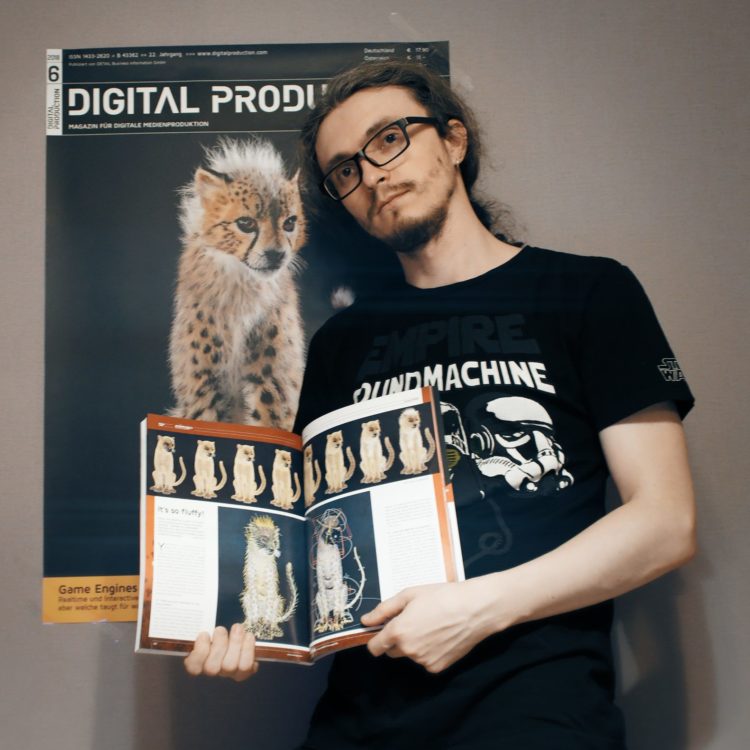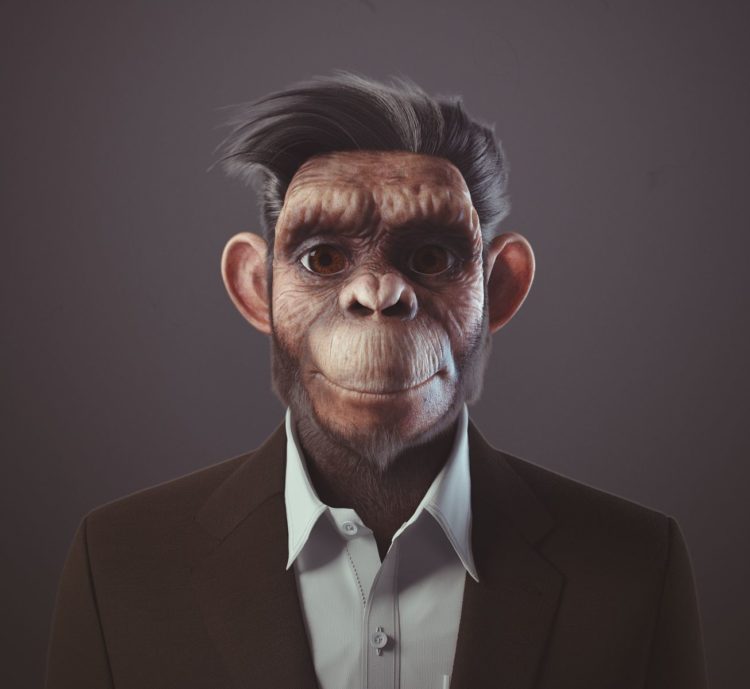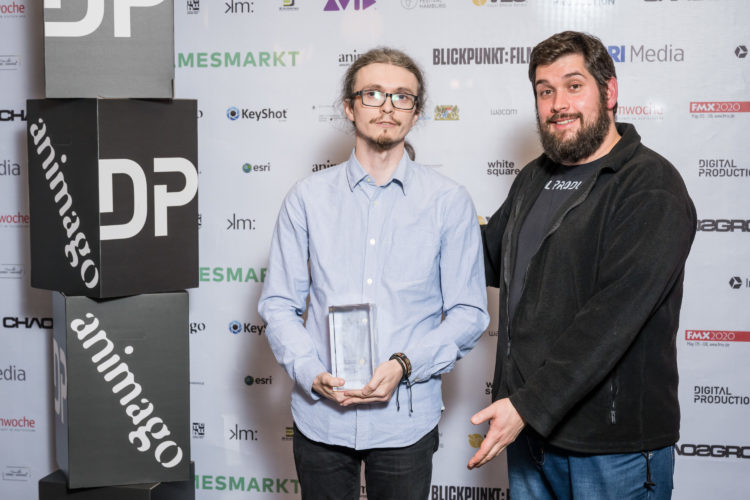As media partners of animago Award – an internationally renowned competition for 3D animation and still, visual effects, visualization and VR/AR/360° – we are happy to present you the winner of the Best Still category this year, character artist Yuriy Dulich from Ukraine. In our exclusive interview, we speak about behind the scenes of his winning project, Subarctic Great Horned Owl: look into the depths, and about his approach to CGI visualizations in general.
Yuriy Dulich
Character Artist | Groom TD
Co-Founder at Biotic Factory
Ukraine

What’s your professional background? How did you start working in CG?
Everything is very simple and banal. In short, this is the story of a teenager who, at school, fell in love with science in general and astronomy in particular, who met with Photoshop at a technical college because he wanted to improve the quality of photographs (still on tape!) of the night sky after astronomical observations. It’s also the story of a student of astrophysics who first learned 3DSMax, and then mastered Maya, because he wanted to visualize the obtained observation data and generally make presentations at scientific conferences more beautiful. And then there was a cruel disappointment in the bureaucracy of science, the stage of student freelance, leaving graduate school. So in 2008, I came to the archiviz studio as a junior 3D Artist, went through all the stages of the career ladder in advertising, managed to be a supervisor on several animation projects, and this year I created my own, so far, virtual studio.
Great Tit
How did your interests and priorities change during your CGI career? If you were able to start anew, what would you change? And what do you consider your most important achievements?
When I first became interested in CG, I tried to learn every specialization. I realized that sooner or later I would have to stop at one or a couple of things that will be a favorite part of CG. Therefore, as a freelancer, I started as a so-called CG Generalist, and in fact, I was able to do everything except good character animation, but at an average level. To do everything at a high level is quite difficult because to keep all the skills in good shape is almost impossible, given the rhythm and specificity of a project. And even when I was a technical supervisor on 2 animation projects, these skills came in handy. Closer to the equator of my career, I began to firmly understand that I am most pleased to work with characters. And in my free and personal time, I developed all the skills in this direction — I studied anatomy, sculpted various organic characters, looked at a lot of materials on organics and techniques, and also tried to sculpt from clay. I also tried to create a hardsurface characters, but as it turned out, this is not mine. Then, while working on a serial animation project, I had to revise the part of my pipeline related to grooming. So I chose Yeti as the main grooming tool. From that moment and for the past 6 years, I have been actively engaged in the creation of both stylized and photorealistic characters, animals and creatures.
What’s your usual workflow working on a CG project? Do you work alone? If not, how do you plan and structure the work inside the team?
Any project I try to lead in a classic way: from pre-production to the final image. There are tasks where I need to do a thorough RND. Such tasks, as well as specific wishes of the client, are discussed in advance and with all the details before the start of the project. This greatly affects the speed of the project and the assessment of all risks. Any creativity should be properly organized. I physically can no longer do everything alone: communicate with a client and create a project. At the moment, our team has 2 regular members: me, as an artist, and my wife as a Project Manager. Over her shoulders ther is an experience the PM in advertising, animated series, and animation feature film. So this is more than just a family business. So, we do a well-structured, well-planned, transparent project for the client. For larger projects, we attract our friends- riggers, animators, VFX, and Lookdev artists. At the moment, there are so few large projects to keep them on core staff, but if necessary we can make a full-cycle project.
You won this year in Best Still category of animago Awards. Can you please tell us more about the Subarctic Great Horned Owl? What’s the story behind this project? How did you get the idea? How long did it take to accomplish it?
It is a great honor for me to receive such a high valuation for which I am grateful to the jury and everyone who voted for my work. It is very motivating. The history of this project is simple and prosaic. The fact is that I like to create photorealistic characters, creatures, and animals. And after a rather successful result with the “Baby cheetah”, it was decided to greatly complicate the task and create a photorealistic bird. We tried to find out if someone did this before us and the result was mixed. Our goal was to develop and expand our pipeline to birds and discover the feasibility of taking into account all the anatomical features of the animal in the process of creation. The choice fell on an eagle-owl since a few people created owls. And given the volume of their feathers, this is an additional problem. You may have a question – why is this dude constantly complicating tasks for himself? And the answer here is simple – complexity, problems and their solutions give us a growth and yes, I love complex tasks. Indeed, simplicity is not only trite but also boring. And the first big problem is the references: with primary feathers of wings, more or less with the look of the owl itself, with the anatomy, where which feather is located and on which part of the body is placed, the real volume of feathers and so on. A lot of material was collected, several documentaries were watched and the top of it all was an acquaintance with a real owl and communication with the ornithologist. As a result, I had an understanding and answers to questions: where is which feather located, what is their density, their length, where do they grow, anatomical features, and so on. And all this during the production … and the whole production took 4 months …
What was your workflow to create the Subarctic Great Horned Owl? Which software, plugins, other tools did you use?
After collecting all the information about plumage and anatomy, tmy work continued. I’ll clarify, from the very beginning, with a lack of references, and until I met the real owl, I began and continued to work. But for this, I used a draft model of the owl and built a draft groom on it. On it, I practiced working with long feathers on the body and trying to independently resolve all issues using only video references. This model and groom have been remade many times. And only after I touched the real owl and everything fell into place, the gears of my pipeline started to spin and the work went as usual. I used my iterative grooming method to speed up and better get the right amount of feathers. The whole assembly was done in Maya, the whole sculpting from the base and the final in Zbrush, grooming and scoring in Yet, texturing in Mari, rendering in Arnold and post-processing in Blackmagic Fusion.
Subarctic Great Horned Owl
What was the hardest challenge for you? If you were starting this project now, what would you do differently?
As I mentioned earlier, the most difficult thing was to find references and figure out what and where. Books partially solved this problem. Nevertheless, the knowledge gained is invaluable. I also considered a simulation option — how then to make it all move correctly? This is essentially the most difficult task in this project, to which I partially answered for myself. And also the answer why the majority artists do not the anatomically correct model of birds, especially such voluminous as an owl. And what would I change- I immediately turned for a consultation to ornithologists, to the zoo or nurseries where there are owls. But I had to pass this way and I am glad that I went in and completed.
What’s next for 2020 (and maybe the coming decade in general)? On which project are you working now?
At the beginning of 2020, we launched a personal project called Biotic Factory, our studio for creating characters, animals, and creatures of any complexity. What we once did for ourselves or as freelancers, now we will do it on an ongoing conveyor basis and for various client tasks. Also, we plan to launch a series of grooming tutorials in Yeti and share knowledge with those who need it. For example, the experimental “Yeti tips and tricks. For kids edition” tutorial, which the artists liked. And we decided that we would release a series of such quick tutorials in this edition. But more serious things will be in a different style. If possible, we will glad to participate in large projects.
What can you advise to the 3d artists that just start their career?
Be open to new knowledge, be like a sponge and absorb everything. When you reach the first peak, do not stop there, compared with what awaits you, the peak just reached is just a knoll. Love what you do, and with all your passion. Do not expect quick results, but try to do the work not for the sake of doing, but for the sake of acquiring new skills and knowledge. Do not hesitate to write to top artists if your interests coincide with him, but do not forget they are people too and you should not torment them with empty questions. Do not forget about relaxation and health. Remember the banal truth – children need healthy parents, and employers do not need sick employees! Spend time with family and friends. Attend conferences and events not only for the sake of obtaining narrow knowledge but also for the development of soft skills. And the last is not very positive advice – no one owes you anything, so when asking a question, do not sit and do not expect that anybody will solve it for you, try to find the answer yourself. It is much better and more productive for you.
Ostrich
In your opinion, what does participation in professional competitions give to artists? what would you advise young artists just starting their career to keep in mind about participating in competitions?
Any competition, in my opinion, is a stress test of all your skills. And also a free assessment not only by a professional jury but also by other artists. In fact, any participation gives you a lot of information – what are your weaknesses, management review, verification of your workflow and much more. And this is the most valuable reward. It may also be a passive award that large studios will notice you and generally begin to talk about you. Competitions are a good platform for such things.
I would advise you to do any work (commercial or for yourself) as if it were a competition, just compete with yourself which is growing with each stage. Be adequate to criticism, it is important! Criticism can kill an artist in you or maybe motivate. When participating in competitions, ask yourself the question “what do I want to get as a result?” This will be your goal and motivation. It’s normal when you want a material prize (tablet, video card, license, etc.), especially at the start of your career. But I would advise getting information that will allow you to grow as an artist.

 English
English




































